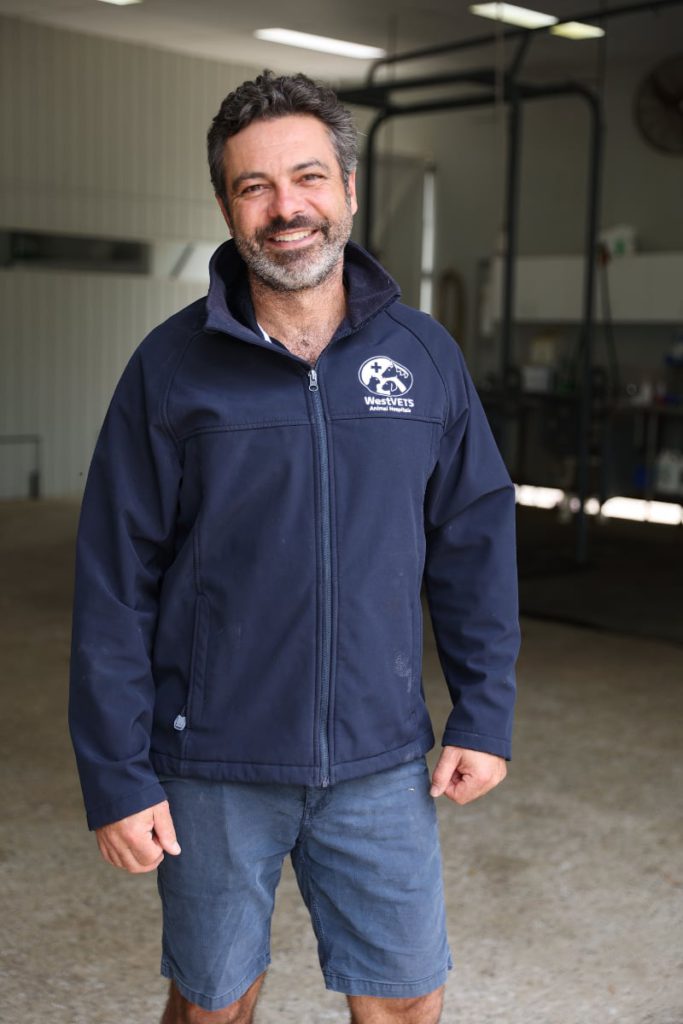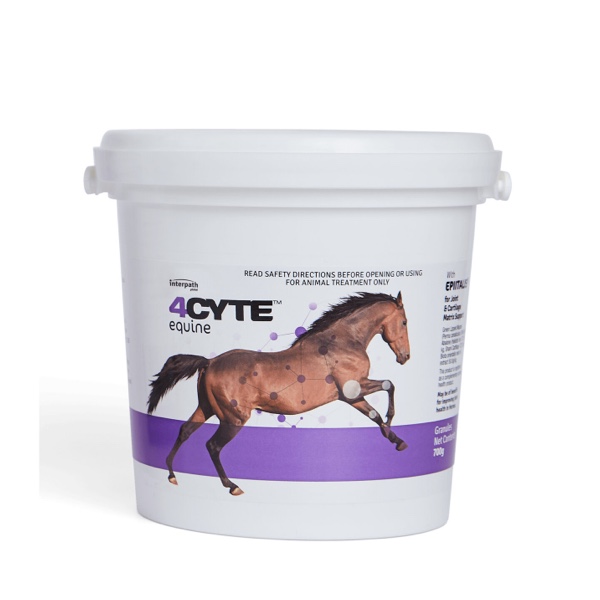Osteoarthritis (“OA”) is a common cause of lameness and poor performance in competition horses. OA can occur for a variety of reasons. It can occur secondary to developmental orthopaedic conditions in young horses; it can occur following an acute joint trauma or it can be as a result of chronic wear and tear from training, competition and age.
Whatever the inciting cause, the end result is excessive inflammation in the equine joint that leads to cartilage thinning and erosion, and a decrease in the lubricating properties of joint fluid. With more chronic cases, the soft tissue supporting structures become thickened which results in a decreased range of motion of the joint. In advanced cases of OA, bone within the joint becomes brittle and fractures can result. Early OA is a common cause of lameness and poor performance and a progression to severe OA can finish a sport or race horse’s career.
“Prevention is better than cure” is certainly true for arthritis in horses. Even with advances in modern medical science, there remains no cure for OA and this is why joint replacement surgery in humans who suffer this severely painful disease is common. With the value of performance horses ever increasing and considering the time invested in training, riders and trainers should be aware of various measures that may prevent OA.
Equine Arthritis Treatment
1. Ensure that you have a realistic exercise or training program
Condition your horse slowly and maintain fitness without excessive workloads. Do not exceed your horse’s capabilities. Also consider the surface you train your horse on; hard surfaces result in greater concussion within the joint whereas conversely deep sand conditions increase the risk of soft tissue injuries.
2. Farrier attention
Regular short shoeing intervals are mandatory with particular attention to foot balance. Poor hoof conformation can result in asymmetric loading of joints which can lead to early OA and an increase in risk of acute overload injuries.
3. Early diagnosis of lameness
Treat any joint disease early and aggressively with anti-inflammatory therapy, ice, and rest. A simple joint strain can result in inflammation that ultimately could be the precursor of the degenerative disease that leads to OA.
4. Optimise joint health with a daily oral nutraceutical
We recommend 4CYTE™ Epiitalis® Forte. This oral supplement contains Epiitalis®, a plant seed extract which is the only oral product available that is scientifically proven to have a beneficial effect on joint health. Laboratory research shows that 4CYTE™ reduces joint inflammation and consequently we see improvement in lameness with reduction of joint swelling and improved range of joint motion. Research also supports the benefits of 4CYTE™ during recovery from traumatic joint injury as it can prevent or slow the progression of degenerative disease. Furthermore, daily nutraceuticals provide persistent anti-inflammatory benefits combating the inevitable “wear and tear” from the stresses and strains of regular training and competition.
5. Addition of injectable medication
Talk to your Veterinarian about the addition of injectable medication for enhanced joint health, particularly for joint disease associated with high intensity training and competition. Examples of these include:
- Pentosan Polysulphate (Pentosan™ / Arthropen™ / Cartrophen™) – This medication improves cartilage and joint fluid quality and provides anti-inflammatory activity to joints. We recommend loading horses with weekly intramuscular administration for 4 weeks, followed by single booster doses administered at 2 – 4 week intervals, as determined by the intensity of work or the severity of OA.
- Hyaluronic Acid (HALO™ / Matrix™) – This medication is also considered to be joint protective and is shown to reduce pain associated with early disease. We find this medication particularly effective when administered by intravenous injection 24-48 hours prior to intense exercise, competition or racing.
- Polysulphated Glycosaminoglycan (Adequan® / Zycan®) – This medication reduces inflammation, improves joint fluid quality and therefore can prevent or slow the progression of OA. We recommend intramuscular injections every 4 -7 days for 7 doses.
6. Intra-articular medications (“joint injections”) are indicated for persistent joint inflammation and for management of confirmed OA
Medicating directly into the joint is the most potent way to curb inflammation and reduce pain. Early treatment can prevent OA or slow the rate of progression of degenerative disease. The more recently developed biologic joint injections – derived from the horse’s own blood – also have anabolic and regenerative properties for enhanced joint repair and healing. The most appropriate type of joint injection will depend on the joint, the severity and chronicity of disease, the age of the horse and the intensity and type of exercise. Examples of these joint injections include:
- Corticosteroids – These are very effective at blocking inflammation at the source within the joint. They “put out the fire”, stopping the damaging effects of inflammation in the joint and they often result in a rapid improvement in lameness. Corticosteroids remain the most commonly administered intra-articular medication by Veterinarians. Low doses of corticosteroids used correctly can improve joint healing, however increased dose and frequency can result in cartilage breakdown.
- Hyaluronic Acid – This is a synthetic protein of the normal component of joint fluid. Hyaluronic Acid has been shown to provide anti-inflammatory properties within a joint with less potential side effects than Corticosteroids. Hyaluronic Acid is often used as a post-surgical injection or combined with steroids to promote improvement in joint health.
- Polyacrylamide Hydrogel (Arthramid®Vet) – This innovative product acts as a dynamic scaffold within the joint capsule increasing the elasticity and load transfer of the joint. This product binds to the synovial membrane reducing exposure of cartilage to inflammatory mediators. Clinically, horses with chronic synovitis and minimal cartilage disruption or young healthy joints with synovitis are the best candidates.
- IRAP® (Interleukin-1 Receptor Antagonist Protein) – This product is an autologous conditioned serum derived from an individual horse’s blood, blocking inflammation through a different pathway to Corticosteroids. This results in a potent anti-inflammatory effect in the joint and the prevention of cartilage breakdown. Blood is collected and incubated for 24hrs with approximately 6 doses produced and stored for future use. Typically, a minimum of 3 injections are administered at 1 – 2 week intervals, followed by repeat injections as required over the first year.
- Platelet Rich Plasma (“PRP”) – This is used more frequently in soft tissue injuries of tendons and ligaments but has gained increasing popularity for healing of cartilage and bone defects in joints. Also produced from an individual horse’s blood, PRP provides an influx of growth factors that act to up-regulate healing of cartilage and bone.
- Autogenous Protein Solution (Pro-Stride®) – This is another natural product that is extracted from an individual horse’s blood for injection. The product combines anti-inflammatory proteins (IRAP®) to block inflammation and the anabolic properties of PRP for cartilage healing. This injection is typically reserved for higher motion joints such as stifles, fetlocks and knees or for treatment post-surgery. A single treatment is effective for more than 10 months. Pro-Stride® has largely replaced the use of IRAP® in our practice as it has the advantage of combining the beneficial effects of both IRAP® and PRP. The stall-side short preparation time allows for convenient, cost effective and immediate treatment without delay.
Osteoarthritis is the most common cause of poor performance and the most likely reason horses are retired early from their competitive careers. Prevention of OA is aimed at reducing risk factors for traumatic joint injury as well as enhancing joint health by reducing joint inflammation with the regular administration of nutraceuticals and the targeted use of conventional anti-inflammatory medication. Successful management of OA is aimed at alleviating pain and stopping or slowing the progression of disease. This requires an early, accurate diagnosis, followed by the implementation of appropriate treatment, rehabilitation and then close monitoring once the horse has returned to training and competition. With early intervention and appropriate management of OA, horses can have long and successful careers.

Dr Nathan Anthony is the founding partner of WestVETS Animal Hospitals. Nathan’s clinical interest and expertise lies in the areas of Equine Sports Medicine and Equine Surgery. He was appointed Head Vet for the Australian Equestrian Team for the 2016 Rio and the 2020 Tokyo Olympic Games and he continues in this role supporting the Australian horses and riders for the upcoming 2024 Paris Olympic Games.

